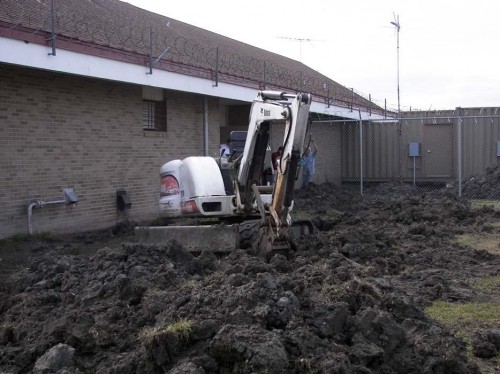
Bertha Walker
January 14, 2008James Akins
January 16, 2008After seven days of sitting virtually idle, the Lafourche Parish Detention Center reopened for business around 11 p.m. Saturday.
Over 200 inmates returned to their cells after the water main exploded Jan. 5, a week earlier, prompting Sheriff Craig Webre to evacuate the facility. Prisoners were bussed to Orleans Parish Prison and Lt. Sherman Walker Correctional Facility in St. John the Baptist Parish.
“The prisoners are back in their bunks and everything seems to be working fine,” Lafourche Parish Detention Center Warden Eddie Rodrigue said early Monday morning.
Parish President Charlotte Randolph declared a “state of emergency” that afternoon, clearing the way for work to begin repairing the fresh water line.
In its first act of business, the newly sworn in Lafourche Parish Council last Tuesday approved $265,800 for emergency repairs. Sealevel Construction and M.T. Plumbing were hired to do the work.
Under the approved emergency orders, the companies will be paid $78,500 to repair the water main. An additional $177,300 will be paid to Institutional Services and Consultants to install a toilet waste fence valve system.
Years of abuse of the plumbing system are blamed for the break in the line, according to Rodrigue.
The warden said inmates routinely flush non-biodegradable items – bed sheets, shoes, clothes and other materials, eventually clogging the line.
“This is a problem for many jails when inmates stuff the lines and back up the sewage because they have nothing else better to do or they want attention,” Rodrigue said.
Lafourche Parish Correctional Department Head Marty Dufrene said other prisons have installed “pea traps,” or waste fence valve systems, to catch large items. Ascension, Assumption and St. John parishes all employ the traps as do the Hunt Correctional Center and Angola State Prison, he said. “[The system] has had remarkable success at those facilities.”
In all, 236 male inmates were relocated to Orleans Parish while 35 women were moved to St. John Parish.
Sheriff Webre said both jails agreed to house the prisoners at a cost of $23 per inmate per day, the same amount charged in Lafourche.
“St. John said it would house [the females] at $23 per day and Orleans said they would hold the males until we came back online,” Webre said. St. Charles Parish also agreed to provide space on a case-by-case basis at the Nelson Coleman Correctional Center if needed, the warden added; however, the additional beds weren’t needed.
At each of the facilities, jailer manpower was a concern, Webre explained.
Jailers normally assigned to oversee inmates at the Lafourche Parish facility were temporarily moved to the jails in Orleans and St. John to monitor local inmates.
Over the course of the evacuation, the Lafourche Parish Jail was able to keep one 20-bed dorm operational. The section was used to house inmates transported back into the parish for court appearances and medical appointments, Rodrigue said. A seven-man shift appointed by the warden transported Lafourche inmates in and out of the parish.
Whenever possible, inmates were arraigned by video, cutting down the number of transports needed.
Throughout the jail closure, Webre said deputies continued to make arrests.
“Anyone who commits a crime just because the jail is not online doesn’t get a ‘get out of jail free’ card,” Rodrigue said.
“We are continuing to process people, and we are giving them 72 hours to make bond,” the sheriff added. “If they can’t, we transport them.”
When the jail was first evacuated, Webre said non-violent offenders were given the option of posting bail. Judges also issued summons for misdemeanor offenses and sentenced some offenders to house arrest whenever possible.
With inmates back in the Lafourche Parish Jail, Webre said the immediate task is to sort out the expense of the evacuation.
Employee overtime spent transporting inmates and working shifts at out-of-parish jails has yet to be figured into the cost, he said.
The week-long ordeal punctuates Webre’s call for a new jail, a point he’s included in his political platform throughout his 15-year tenure as sheriff.
“We needed a new jail 15 years ago in terms of capacity,” the sheriff said. “We had a problem with overcrowding from day one, but it is more chronic today.
“The building is deteriorating on a daily basis… in other words, it’s dying.”
Built in 1976, the jail was designed to house 76 inmates, Webre said. Today, the facility has been reconfigured to handle more than triple the load – 243 inmates.
The jail is sectioned to house hardened criminals in single-man cells, less violent offenders in four-man cells and women prisoners in a separate wing with four-person cells.
At most, the jail holds 35 women at any one time, Rodrigue said. Ironically, the women’s wing, the smallest sector of the inmate population, was evacuated during Hurricane Katrina, marking the only other time inmates had to be relocated from the Lafourche Parish Jail.
Women inmates were temporarily housed at the Louisiana Correctional Institute for Women in St. Gabriel Parish until water from the storm subsided.
“We started out processing five to six inmates a day,” the warden said. “Over the years, we have gradually increased to where we are processing anywhere from 20 to 30 inmates a day.”
Unlike the crime in neighboring Jefferson and Orleans parishes, Rodrigue said the influx in Lafourche Parish is not attributable to the 2005 hurricane season.
“Arrests in crime changes all the time. People are getting arrested for more crimes,” he said. “A lot of people don’t realize that the people we take in are not just from the sheriff’s office.”
In fact, the Lafourche Parish Jail houses offenders arrested by the state police, City of Thibodaux Police, port commission, Louisiana Department of Wildlife & Fisheries and authorities from the parish’s various cities and towns, Rodrigue said.
“We have always added inmates, but never done anything to improve their support,” the warden said. “We need to do something with the plumbing, kitchen, laundry room, storage area, learning center and the locking system.”
Virtually every realm of the antiquated 31-year-old facility has been outdated or in need of repair, he said.
For the short haul, Correctional Department Head Dufrene said the parish will have to fix the current problems to keep the facility running. To do that, he said, a committee will be needed.
It isn’t the first correctional facility committee in Lafourche Parish’s recent history. Such a committee did exist up until 2005, but it disbanded shortly after Hurricane Katrina hit, Dufrene said.
“I think the parish has to sit down and brainstorm, looking at different situations like building a new jail or adding on to this one,” he said. “We have a good lockdown facility, but we don’t have enough space to house the inmates.”
Webre agrees this will take the entire Lafourche Parish government to fix.
“The jail is a critical component to the proper functioning of the criminal justice system,” Webre said. “The law is very specific. It says that the sheriff ‘operates’ the jail, plain and simple.
“Everyone in the judicial system has a vested interest in the jail,” he said. “The courts and the judges who sentence people cannot do their jobs without a parish jail. The district attorney’s office prosecutes people for convictions. The parish government provides general health, safety and welfare of its citizens and for them to fulfill their duties, a parish jail is needed,” he said.
Webre said it is too soon to determine if more taxes will be needed to fix the problem.
“We don’t have a tax and I am not suggesting that we need a tax right now,” he said. “I am suggesting that we examine the current situation of what we are expending and what we anticipate expending. Then we can ask, ‘Do we need a tax?'”
Monday afternoon, Parish President Randolph said she was pleased with the detention center repairs.
“It’s a relief,” she said. “This situation was very tedious and expensive, but we were able to accomplish something that we weren’t able to do in the past and that’s get a good working pumping system.”
The parish government allots $1 million annually for the maintenance of the detention center and inmate medical and housing expenses. Randolph said a new jail would be too much for the parish to handle budget-wise any time soon.
“We definitely have to do something but a new facility would be too expensive,” Randolph said. “I would prefer exploring the option of finding a way to add on to the current facility. And, if that’s not feasible, then I would look at a new structure.”
Like Webre, the parish president favors reassembling the detention center committee to review possible improvements the current jail. She said, “We need someone from the sheriff’s office to form a group and look at the things that need to be done at the detention center.”
Workers repair a fresh water main line at the Lafourche Parish Jail last week. The emergency repair cost the parish $265,800, and caused inmates to be relocated to surrounding prisons while work was completed. * Photo by SOPHIA RUFFIN














